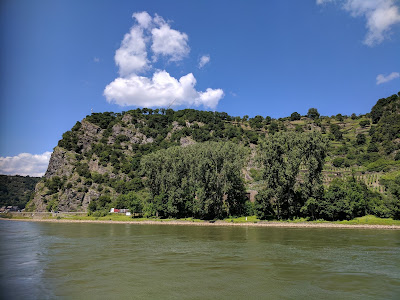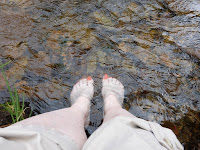The HER2 results are in.
As you may remember, the first biopsy did not have enough tissue to assay my HER2 status, but the second one surely did. The dear doctor (I liked him quite a bit) took multiple samples from all of the areas, using carefully guided ultrasound. He did an amazing job. We joked that the lab was going to open the samples and exclaim “What is all this?” Nonetheless, they had enough this time, and the conclusion was clear:
I am not HER2 positive anymore. There was no HER2 response at all.
So, what does that mean? I'll explain: One of the most effective ways to target the cancer fight it to be able to target HER2.
 |
| Well, which is it? Negative. |
HER2/neu is a protein on the surface of breast cells. (HER stands for Human Epidermal growth factor Receptor, not that you wanted to know.) In some breast cancers, it gets too active and promotes the cancer growth. Being able to target and kill HER2 positive cancer cells was a small revolution in breast cancer treatment. It is part of the recent improvement we’ve seen in breast cancer survival. The cells respond well to Herceptin, and some women are surviving DECADES because of the ability to kill these cells.
But, things can change. Positive to negative and back again — this can happen all the time, we are learning. It happened to me.
I know I was HER2 positive once, and the Herceptin/Perjeta/Navelbine worked for quite a while. In fact, I like to think that combo got all the HER2 positive cells.
But then, it seemed to stop working. Why? Because I also had HER2 negative cancer AT THE SAME TIME. Now, it’s time to go after them. There are still several effective treatments for me. And studies and….lots more. I just wish we knew sooner.
- I am *not* in the HER2CLIMB study. Yes, I’m sad about that, too.
- As I mentioned before, knowledge is power. We now have a better idea what to use to address what seems to have been a losing battle. I’m starting Xeloda, a well-known oral chemo, on Tuesday. I will now take pills to treat my cancer. No more infusions for a while!
- I will admit to some frustration, because I still suffer from Kadcyla syndrome (my new name for the fevers and aches) and it was wholly unnecessary. Kadcyla was completely useless.
So, I have an appointment for a second opinion with….MD Anderson. I know, I’m shocked, too! I had been turned down but now I’m in. I had read that they are studying a similar syndrome as mine — one being experienced by many of the CAR T study participants. (CAR T therapy is revolutionary for leukemia and soft cell cancers. It actually cures. They hope to figure out how to make it work for solid tumors like mine someday.)
But nothing is easy: There is a great, big tough side effect (Adverse Event, they call it) called “Cytokine Release Syndrome.” The symptoms are the same same same as mine. It seems that monoclonal antibody treatments (like Kadcyla) have some unexpected turns. Because all of this is so new, they are just learning now how to deal with it. When I read the article about MD Anderson’s work on the syndrome, I decided to try them one more time to share my experience. And, as our French tour guide would say: Voila! I’m in.
Meanwhile, I will have new regimens for the Xeloda. It’s known for some uncomfortable side effects, lots of them GI related. I will also have to avoid something called Hand/Foot Syndrome. Doesn’t this sound like a load of fun?
Following administration of chemotherapy, small amounts of drug leak out of very small blood vessels called capillaries in the palms of the hands and soles of the feet. Exposure of your hands and feet to heat as well as friction on your palms and soles increases the amount of drug in the capillaries and increases the amount of drug leakage.This leakage of drug results in redness, tenderness, and possibly peeling of the palms and soles.The redness, also known as palmar-plantar erythema, looks like sunburn.The areas affected can become dry and peel, with numbness or tingling developing.Hand-foot syndrome can be uncomfortable and can interfere with your ability to carry out normal activities.
--October 15, 2017 http://chemocare.com/chemotherapy/side-effects/handfoot-syndrome.aspxOh, goody. Can’t wait. At least, I don’t have to do the dishes anymore! W00t!
That brings me to my next post; one I will bring to you soon. We need to talk; I want to explain why I might not want to see you right now -- or, how to visit someone with cancer.
As always, your targeted comments are most welcome.








